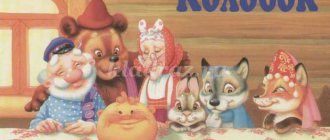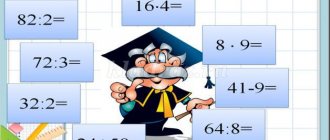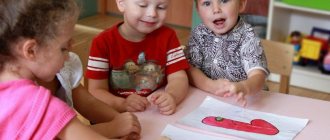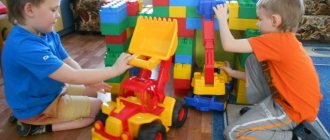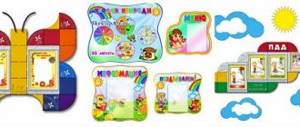The value of quality motivation
Raising a child is an art. It is not enough to instill the basics of morality and behavior in society. The task of parents is to raise a worthy person, adapted to independent life. Many years of experience show that the carrot and stick method in education does not give the desired and sustainable results. It is useless to force a child against his will to do something that, in his opinion, is not necessary. But the right motivation can work real miracles.
You can motivate children to study, play sports, engage in art, and much more. And to start the process, parents need to become more familiar with what motivation is, what its types are, and how to properly motivate a child, guided by his personal characteristics, without the involvement of specialists.
Seminar for young educators Topic: “Methods of activating children during educational activities”
Pedagogical activity (any children's activity: play, work, drawing, educational, productive activity) should contribute to the development of children. Therefore, it is necessary that children not only do everything that is required of them, but also transfer this into their independent activities. And this will happen only if the new knowledge and skills that we strive to pass on to children are necessary and interesting to them, if children have what we learn by solving a crossword puzzle. (Crossword) (Crossword on Power Point presentation)
Each of the newly arrived “heroes” - objects asks who lives in the tower, and the “resident” - the object must answer him, listing who he is, what he is like, what he can do. In turn, the arriving “object” names itself and also describes its properties and functions. The “resident” of the mansion invites the newcomer to live with him.
Please note => How long does 2 liters of beer disappear from a man’s body?
Types of motivation
Motivation is interpreted differently by specialists, but in a general understanding it is the ability of an individual to satisfy his needs and desires through activities. But the process of third-party motivation can be compared to manipulation, which can be positive and negative. According to V.K. Vilyunas, motivation is a whole system of processes that encourage a person to act.
Experts in the field of psychology identify 6 types of motivation, these are:
- External. It is not related to a specific process, but is determined by the result. For example, a child studies not for the sake of gaining knowledge, but for the sake of high grades, praise and receiving other awards.
- Internal. The direct opposite of the previous look. A person is little interested in the result; he is completely immersed in the process of completing the task itself. Intrinsic motivation may include:
- Cognitive motives. They are based on an interest in acquiring knowledge and skills. Motivation is formed at an early age and depends on many conditions: the level of development of the nervous system, the nature of upbringing, family situation, etc. If the innate cognitive motive is not supported, it will need to be restored in the future. Therefore, it is useful to attend exhibitions, excursions and other educational events even with young children.
- Social motives. They imply the child’s desire to be useful, first in the family circle, and then in society. This also includes the desire to become literate, successful, and learn to interact with the team and others.
- The motive for avoiding failure. In this case, children do everything to avoid bad grades and disapproving remarks addressed to them. With such motivation, it is the grades that will determine how strongly the child will strive to study and whether he will do it at all.
- Achievement motivation. During school years, as a rule, it is this motivation that becomes dominant. It can be seen especially clearly in children with a high level of academic achievement. It is important for them to complete tasks efficiently and on time and to receive appropriate encouragement. The purpose of such motivation is to become a professional. The child can deliberately take on difficult tasks and make every effort to solve them.
- Positive. Motivation, which is based on positive stimulation. An example of a child’s positive motivation: “if I learn my lessons, I’ll get sweets and go on the rides.”
- Negative. Motivation that comes from negative incentives, for example: “if I don’t learn my lessons, I will be punished.”
- Sustainable.
- Unstable.
How to prepare organized educational activities in accordance with the Federal State Educational Standard for Education
5. The teacher is simply obliged to provide children with “freedom of choice” for upcoming activities and, at the same time, to captivate children with their skill. For example, the teacher of the first junior group told the children the fairy tale “Kolobok” during an educational lesson, and then offered motivation for the upcoming activity (collective application of the character Kolobok) “Guys, Kolobok ran away from his grandparents, they are crying bitterly. How can we help our grandparents? Then he offers possible answers: maybe we should draw a Kolobok and give it to our grandparents? Thus, she captivated the children, organized motivation for drawing, got them interested, and also solved the educational task: to make the children want to help their grandparents in finding Kolobok. Also, in the first part of the educational activity, it is necessary to create a problem situation (or a problem-search situation) for children, the solution to which they will find throughout the entire event. This technique allows preschoolers not to lose interest, develops mental activity, and teaches children to interact in a team or in pairs.
Please note => Who receives benefits for labor veterans of the Arkhangelsk region in 2020
Nuances of motivating preschoolers
At the age of 6-7 years, each of the above motivations takes place, but the predominance of any one has an impact on the formation of the individual’s character and his studies in the future. It is difficult to determine the predominant type of motivation, since children often answer stereotyped questions. For example, if you ask a child whether he wants to go to school, he will most likely answer in the affirmative without hesitation, which is due to several reasons. Firstly, children know what answer adults want from them, and they give it. Secondly, the child does not have sufficient knowledge of what learning at school entails. Therefore, he cannot give an accurate answer without understanding the essence of the question.
The basic needs of preschoolers are formed in early childhood, therefore, in the process of developing a child’s motives, the family is of great importance. The motivational basis of schooling is based on:
- the individual’s desire to receive information from books, magazines, reference books, etc.;
- awareness of the importance of learning;
- the ability to find a balance between “I want” and “I need”;
- the ability to complete things started;
- the ability to give a competent assessment of one’s actions and results obtained, to identify one’s own mistakes;
- adequate self-assessment.
The most powerful motivator for any child is the opportunity to receive a reward. In order to get what they want, children can do things that are unpleasant and boring for them. An example of this can be observed in the process when a child washes the dishes, tidies up the room, knowing that upon completion of the task there will be a pleasant reward in the form of watching cartoons or a computer game. In this case, we can also talk about the voluntary replacement of one’s “want” with an adult “need.”
MAGAZINE Preschooler.RF
“Creating play motivation at different age stages”The topics of OOD, its purpose and course involve a creative approach. I try to use as many means as possible to make educational activities interesting, educational and educational in nature! Children are very affectionate, trusting, and inquisitive. Each activity opens up something new for them, which then becomes their own, familiar, understandable, and close to them. They do not like monotony, they cannot listen for a long time, or sit quietly. They love to play. That's why I include games during the learning process. During OOD we play serious and smart games. But we play not for the sake of playing, but in order to awaken in all children the spark of inquisitiveness and curiosity. People come to us and we invite famous heroes of children's fairy tales, cartoons, cheerful and funny people to visit us. They ask children “tricky” questions, bring letters with requests, tasks, puzzles, etc.
Someone went to visit children, to those who correctly explained the route from kindergarten to their home.
Why always came with difficult questions. He himself is very literate and knows a lot. He is upset if few of the children can answer his questions. After all, something interesting and mysterious is remembered for a long time.
The children loved it when Pinocchio appeared in class and loved correcting his mistakes. Dunno was also interesting to them.
This is how I taught my children a lot using elements of play. Their mental stress and fatigue disappeared. They quickly and eagerly completed all tasks.
So, a serious, purposeful game helped to consolidate the children’s knowledge, summarize the lesson, and relieve mental stress.
Playing in preschool is one of the favorite activities.
Therefore, the game method occupies an important place in the education of preschoolers. Creating game situations allows you to attract the involuntary attention of children. In a game setting, it is easier for a teacher to activate children’s attention, keep it focused on the proposed content, and develop interest in working in a group environment.
The opportunity to develop creative abilities in preschoolers through play attracts the teacher’s attention to this type of children’s activity and allows him to use gaming techniques in the classroom.
When conducting games, children’s knowledge and interest are taken into account, to know and take into account the children’s gaming experience, to imagine what specific tasks are solved during educational activities when using one or another gaming technique.
The game is offered by the teacher, and this is how it differs from free play. The game should feel like a real game. One of the signs of a gaming technique is a gaming task - determining the goal of upcoming gaming actions by the teacher or children.
Age-appropriate play provides children with incomparable joy and allows adults to effectively guide their actions.
To arouse and maintain children’s interest in activities aimed at mastering basic knowledge and skills and developing cognitive activity, gaming techniques are widely used. Often the entire lesson is conducted in the form of a game.
- Tell the children that something happened to some game characters. As a result, they urgently need those objects that can be sculpted, drawn, built, etc. The characters themselves cannot do this, but they have heard that in this group there are very kind and skillful children who will help them.
- Ask the children if they agree to help (wait for an answer - consent).
- Invite the children to teach them how to do this very well (also wait for an answer - consent).
- During work, each child should have his own ward toy character, who is nearby and rejoices along the way, expresses his wishes, etc.
- These toys are also used by the teacher to evaluate the children’s work, which is given on behalf of the toys, as if from their position.
- At the end of the work, children must be given the opportunity to play with their charges, using the resulting product if desired.
It is advisable that the teacher’s stories should mostly feature the same characters. Then the children will love them and acquire a lasting interest in their lives and the events that happen to them.
The children's favorite was the bear cub Misha, a puppet theater character. He knows how to talk, pat the most distinguished people on the head, shake his head and feel sorry if something didn’t work out for someone or someone is upset about something. Misha congratulated the children on their birthday. He looked into children's works and “whispered” words of approval. Sometimes he would get angry with someone and go back into the forest. The forest is quiet, no one makes noise or bothers him. The children were interested in him and tried not to offend him so that he would not leave. They believe that Misha, like them, can think, get angry, and be happy. After all, children have no boundaries between the real and the imaginary.
The need to create play motivation continues in the older group of preschool age.
Game techniques are used to arouse preschoolers’ interest in the proposed tasks.
Already on the new program content, solving new educational tasks, the teacher continues to present children with tasks that are difficult for them in a playful form, introducing motives that encourage preschoolers to do their work efficiently.
The preparatory group also uses game-based teaching techniques, but their share is significantly reduced, giving way to other techniques that allow children to form a conscious attitude towards the learning task.
In the senior, preparatory group, it is advisable not to include didactic games, but to unite them with a single theme, plot. For example: travel (to the forest, circus, space, etc.).
Game forms of OOD: performance, fairy tale, meeting, etc.
Every time we prepare for OOD, we repeatedly find it difficult. How to start? Why? To make it interesting for children. Our children love to travel, so I spend OOD in the form of travel.
I travel on a variety of occasions:
"To the land of fairy tales".
"To the Land of Curiosities".
"To Fantasy Island".
“A trip to the Arts Square , where we will get acquainted with architectural monuments.”
"Space flight on a rocket" . Etc.
Let me give you an example (construction).
— Guys, are you ready for our next trip?
- Check if you took everything with you? Did you remember to take your imagination, invention, and good mood with you on the journey?
Before we map out the route for today's journey, listen to a story.
One day in a museum they accidentally discovered an old envelope that had fallen behind a shelf. Its edges were very frayed. The appearance of the mysterious envelope indicated that he had experienced a lot in his lifetime. The envelope attracted the attention of museum workers, and they immediately opened it. There lay a scrap of a letter, yellowed with age. In all likelihood, it belonged to some traveler. This envelope is with me now. Let's read it.
“On the map I depicted the location of the island, but, unfortunately, I cannot convey to you the beauty of its castles, palaces, towers, which was told to me by a person who visited this island and took part in its development. He also noted that all the structures were erected from rectangular, square and triangular blocks of various sizes.
It’s a shame that this fabulously beautiful island no longer exists.”
— Guys, what do you think was written next, what did the traveler dream about? (The traveler dreamed of restoring these marvelously beautiful buildings).
So, we will go to Stroiteley , where we will have to prepare construction details and plan the structures.
Let me give you an example of a mathematical train journey.
— Now you and I will go on a mathematical journey, where we will solve problems, examples, and count. We will learn ourselves and teach others.
Our train is unusual - mathematical. (I display a train and several trailers.)
And our familiar little engine brought us interesting tasks.
(Then the children complete tasks: for example: name the geometric shapes that make up the train and trailers, count how many trailers, etc.)
You can start OOD with a surprise moment (someone sent a telegram, a meeting with a literary hero, a letter of invitation, a meeting with various animals, dolls).
OOD can be started by listening to a piece of music, by asking riddles, by making up a fairy tale, by having a conversation, by reading an excerpt from a poem, by reading an invitation card, by viewing a painting, etc.
When conducting OD on FEMP, when becoming familiar with the concept of “order,” you can use this method.
When studying the concept of “order,” it is useful to arrange children in accordance with some order: by height, by age, by number order, etc. You can count various objects forward and backward. For example: based on the pictures, suggest questions and tasks: (pictures: boy, fish, cat, hare, butterfly, wolf, chicken, bird, moth, bee).
- Count everyone in order (the first is the boy, the second is the fish, etc.).
- How much is a bunny worth? Wolf?
- Who is located next to the butterfly? In front of her? After her?
- What is the kitten's value from the end?
Children really like this game to develop attention: they close their eyes, and the teacher changes the order of objects or removes some object. We need to restore order.
According to FEMP. "Exploring the number 7 and the composition of 7" .
The number is illustrated on a number line as the result of adding 1 to the number 6. The composition of the number 7 is shown.
The number 7 played a large role in ancient mythology (7 Roman gods, seven wonders of the world in Ancient Greece, etc.) and retained this role in literature. They remember the 7 dwarves from the fairy tale about “Snow White and the 7 Dwarfs” , you can read an excerpt from the fairy tale by A. S. Pushkin “About the Dead Princess and the 7 Bogatyrs” . Everyone knows the proverbs and sayings in which the word “seven” : “Seven do not wait for one” , “Measure seven times - cut once” , “Seven troubles - one answer” , “One with a bipod - seven with a spoon”, etc. In these proverbs and sayings, the word “seven” acts as the word “many” . You can remember that we use a seven-day week, we talk about the seven colors of the rainbow.
I consider motivation to be mandatory and one of the main elements in the upbringing and education of preschoolers. Otherwise, we risk ruining our children's childhood. Whatever preschoolers do within the walls of our kindergarten, they must do it with interest, so that their eyes light up, so that the children enjoy communicating with us. Otherwise it will be hard work. We will develop the child’s head, but his soul will suffer.
| Next > |
Developing a positive attitude towards learning
In general terms, there are two ways to create a child’s positive motivation to learn.
The first is to form positive emotions in the preschooler in relation to the very process in which the child is involved. This can happen in several ways at once:
- approval from the teacher;
- parents' faith in their child;
- encouragement even for the smallest achievements;
- adult support and interest in what the child is doing.
In this case, you should avoid criticizing the preschooler, focusing on what he does well, and not on where the child failed.
The second path involves the process of creating positive motivation for learning through awareness of the importance of learning. The benefits of learning are explained to the preschooler in detail and over a relatively long period of time, and what exactly the child will gain from studying. He must understand that he needs education (for example, to achieve a desired result in the future), and not his parents or teacher. However, such motivation of preschoolers cannot be called sustainable. As soon as a child loses the desire for what he was initially set up for, his motivation will fade away.
Important conditions for developing motivation in preschoolers
The main conditions that are necessary for the successful motivation of preschool children include:
- The need to generate interest in activities in a child, using his innate curiosity.
- Let your child know that adults believe in him. Encouragement and faith should come not only from parents, but also from the teacher. It is important to teach a child not only to appreciate the result achieved, but also to realize the importance and value of the process of achieving it. It is necessary to highlight the characteristics of each child, emphasizing his individuality, and not evaluate everyone according to one criterion.
- Teach a preschooler to set a goal, outline ways to achieve it and plan his activities. This point also includes the skill of predicting the result, i.e. “if I do ..., then it will result ..., and if I do ..., then this will lead to ....”
- Intentionally set tasks for the child, in the process of solving which new ones will arise for him.
- Learn to explain your successes and failures.
- It is important to focus not on the personal qualities of the individual, but on his actions. It is not the child who needs to be praised or criticized, but his actions or results.
- Maximum support the curiosity and activity of the preschooler, his initiative. Help implement children's ideas, cope with mistakes and difficulties.
To provide adequate conditions for effective motivation, it is necessary to create a favorable psychological climate. It is very difficult for a child to concentrate if there are constant conflicts in the house. This causes fear and other negative emotions in him.
Illustrative examples of motivating preschoolers
When developing motivation in preschool age, parents' actions do not necessarily have to be aimed at learning itself. For example, you can develop perseverance in a preschooler with the help of games, and he will apply the acquired skill in his studies.
Here are some examples of how parents can influence a child and stimulate activities that he or she initially dislikes.
Labor activity
Probably every parent will agree how difficult it is to introduce a child to cleanliness and order, and especially to the cleaning process itself. But everything can change if you switch to the game. For example, toys can be helped to get to their houses (placed on shelves or put them in a box). You can involve your child in real cleaning through personal example and by setting simple tasks for him, in which he will act as an assistant.
Few children will be able to refuse the “adult” act of dusting or washing a small area of the floor. The parent’s task is to thank, praise the child and make it clear that without him it would be more difficult to cope with the task. It is important to refrain from criticizing a child if he has done something wrong - this will forever discourage him from wanting to clean up.
Least favorite dishes
Children do not yet understand the benefits of foods, so they only want to eat tasty things. Feeding a child, for example, porridge, often becomes an impossible task for parents. But motivation will come to the rescue here too. And there are many options here - from the interesting design of the dish itself to the use of fascinating stories and fairy tales during the eating process. You need to show your imagination and serve your child a dish that will be decorated in an unusual and attractive way. This will make the child want to eat everything offered.
Another way to feed your child something he doesn't like is to use his imagination. You can imagine the dish not as food, but as an army of useful soldiers who want to protect his health, strength (for boys) and beauty (for girls). But they can get inside and start working only if the baby himself helps them, i.e. will eat The more colorful and interesting the process is presented, the more effective this method is.
Two common mistakes parents make
The first mistake that most parents make is that they do not support their child’s desire to learn new things. After a day of work, adults are tired, and they do not have the strength to answer the child’s questions. Not every parent wants to make an effort to explain something incomprehensible to their child, because it is much easier to say the stereotyped “when you grow up, you will find out” or “stop asking all sorts of nonsense.” If a preschooler regularly receives such an answer, his curiosity simply fades away, as does his motivation. Under no circumstances should you push your child away in such situations. You need to try to explain everything simply and understandably to him. If suitable words do not come to mind, you can always turn to children's encyclopedias, educational programs and cartoons. Even if the parent does not know the answer to the question posed by the child, you can honestly say this and offer to look for the answer together in relevant sources of information.
The second common parental mistake is to assign the task of shaping the motivation of a preschooler to third-party institutions: first to the kindergarten, and then to the school. The same category of errors includes the delayed reaction of adults who believe that at 2-3 years old a child is still too young to be motivated, and at 5 years old he also still does not understand anything. This is a very big misconception! Just at the time when the child just begins to lead an active social life, takes his first steps (and this happens at about 1-1.5 years), it is already necessary to pay more attention to motivating the child. If you don’t miss the moment, studying will be much easier in the future. The child will strive to learn on his own without additional stimulation from adults.
Advice for parents of preschoolers
As mentioned earlier, basic motivation originates in the child's family, so parents should take an active part in preparing the preschooler for learning.
Experts in the field of child psychology suggest using the following practical recommendations:
- In the process of motivating a preschooler, it is important to take into account the child’s interests, his individual needs and priorities. At the very beginning, the main goal is not to educate the child, but to instill a desire to learn with pleasure. For example, if a child likes poetry, then the developmental process should be built on this, and even the multiplication table can be taught using rhymes.
- It is very important to create a positive image of school in your child. It sounds very simple, but in society a child may hear the opposite. The situation becomes more complicated in families with older children who complain about school and how difficult it is to study there. Such statements form a strong opinion in the child about the educational institution as something bad and boring. It is necessary to protect the child from such feedback.
- Create a rough idea of the school. Since the child cannot yet understand what exactly is taught at school and what he will have to do there, information can be presented in a playful form. The peculiarities of the motivation of preschoolers lie in the fact that everything is learned through games. For example, drawing cheerful and bright pictures - ART; jumping, games - physical education; reading exciting stories and fairy tales - literature. Such a pastime will give the child positive emotions, and he will understand that school can be very interesting.
- Development of horizons. Although a preschooler is small, he already has his own opinion, accumulated experience and knowledge. It is very useful to talk with your child on intellectual topics and ask his opinion on various issues. You need to perceive a preschooler as a small adult, then he will feel that his opinion is important and interesting, which means he needs to learn more in order to communicate later.
Methods and techniques for developing a child’s motivation for classes
- sharply negative emotional reaction of children to an invitation to a lesson;
- attempts to delay the start time of classes;
- absence of any questions about the upcoming lesson;
- increased distractibility of children throughout the lesson;
- passive or negative reaction to proposed tasks;
- reluctance to overcome encountered difficulties, indifference to what is happening
Please note => International passport registration through government services, terms, price, Moscow
Visual and gaming tools contribute to the development of the lexical and grammatical structure of speech, spatial relations, visual perception, attention, memory, thinking, and speech practice. These can be subject pictures, illustrations, plot pictures, visual teaching aids and games, made of bright, modern, easily processed materials, aesthetically designed.
